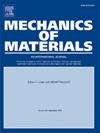Inverse design of interpenetrating phase composites with targeted stiffness through deep learning
IF 3.4
3区 材料科学
Q2 MATERIALS SCIENCE, MULTIDISCIPLINARY
引用次数: 0
Abstract
Interpenetrating phase composites (IPCs) contain at least two interconnected phases. It is still challenging to establish the topology-property mapping and inversely design IPCs with targeted properties. A deep learning model is proposed to design new IPCs with various material symmetries. Hybrid triply periodic minimal surface (TPMS) scaffolds are mathematically designed as the reinforcement phase to construct the IPCs. The IPCs display orthotropic, tetragonal and cubic material symmetries, whose stiffness tensors are determined using a numerical homogenization method. A robust dataset is generated to establish the topology-property mapping. Then, a tandem dual-network model, including a forward sub-model and an inverse sub-model, is developed to predict the stiffness tensor and design the topologies. In addition, the hyperparameters are optimized to improve the accuracy of the model. The dual-network model provides excellent prediction and design capabilities. Moreover, the inversely designed IPCs can fulfill the requirements of the targeted stiffness both in and beyond the original dataset, which include orthotropic, tetragonal and cubic material properties. The current study provides a feasible approach to the forward prediction of elastic properties and inverse design of topologies through deep learning.
基于深度学习的目标刚度互穿相复合材料反设计
互穿相复合材料(IPCs)包含至少两个相互连接的相。如何建立拓扑-属性映射关系,并根据目标属性反向设计ipc,仍然是一个挑战。提出了一种深度学习模型来设计具有不同材料对称性的新型IPCs。混合三周期最小表面(TPMS)支架被数学设计为构建IPCs的增强相。IPCs具有正交各向异性、四方和立方的材料对称性,其刚度张量采用数值均匀化方法确定。生成鲁棒数据集,建立拓扑属性映射。然后,建立了包含正向子模型和逆向子模型的串联双网络模型,用于刚度张量预测和拓扑设计。此外,还对超参数进行了优化,提高了模型的精度。双网络模型提供了良好的预测和设计能力。此外,反向设计的IPCs可以满足原始数据集内外的目标刚度要求,包括正交异性、四方和立方材料特性。本研究为通过深度学习进行弹性特性的正向预测和拓扑的逆设计提供了一种可行的方法。
本文章由计算机程序翻译,如有差异,请以英文原文为准。
求助全文
约1分钟内获得全文
求助全文
来源期刊

Mechanics of Materials
工程技术-材料科学:综合
CiteScore
7.60
自引率
5.10%
发文量
243
审稿时长
46 days
期刊介绍:
Mechanics of Materials is a forum for original scientific research on the flow, fracture, and general constitutive behavior of geophysical, geotechnical and technological materials, with balanced coverage of advanced technological and natural materials, with balanced coverage of theoretical, experimental, and field investigations. Of special concern are macroscopic predictions based on microscopic models, identification of microscopic structures from limited overall macroscopic data, experimental and field results that lead to fundamental understanding of the behavior of materials, and coordinated experimental and analytical investigations that culminate in theories with predictive quality.
 求助内容:
求助内容: 应助结果提醒方式:
应助结果提醒方式:


